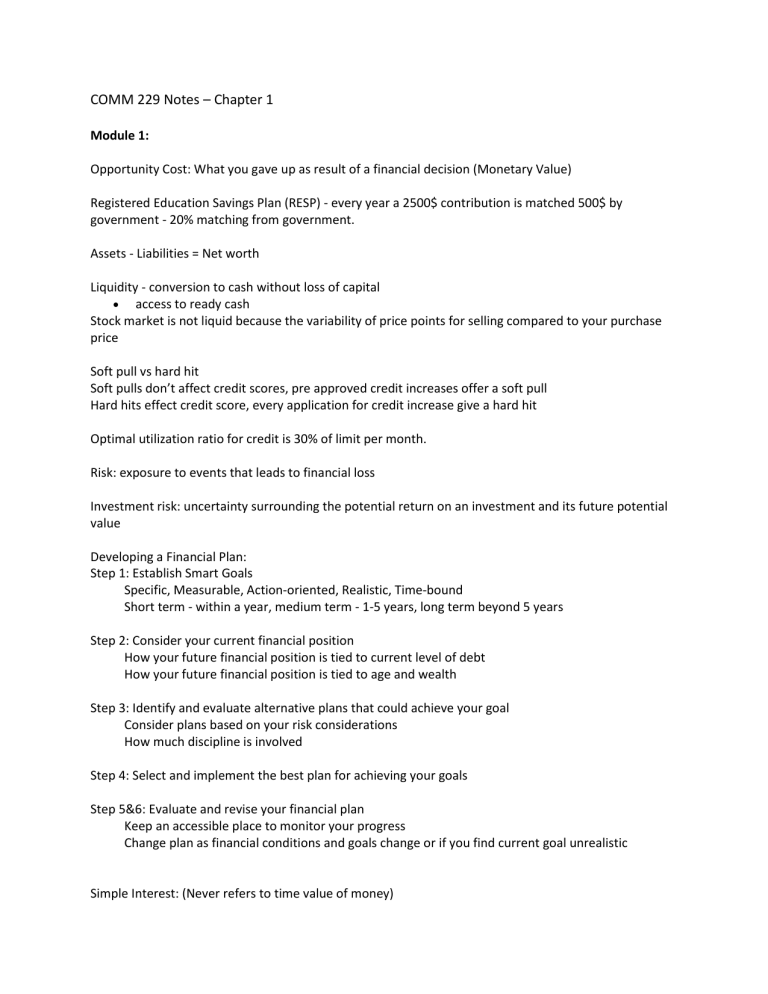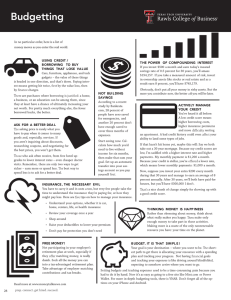
COMM 229 Notes – Chapter 1 Module 1: Opportunity Cost: What you gave up as result of a financial decision (Monetary Value) Registered Education Savings Plan (RESP) - every year a 2500$ contribution is matched 500$ by government - 20% matching from government. Assets - Liabilities = Net worth Liquidity - conversion to cash without loss of capital access to ready cash Stock market is not liquid because the variability of price points for selling compared to your purchase price Soft pull vs hard hit Soft pulls don’t affect credit scores, pre approved credit increases offer a soft pull Hard hits effect credit score, every application for credit increase give a hard hit Optimal utilization ratio for credit is 30% of limit per month. Risk: exposure to events that leads to financial loss Investment risk: uncertainty surrounding the potential return on an investment and its future potential value Developing a Financial Plan: Step 1: Establish Smart Goals Specific, Measurable, Action-oriented, Realistic, Time-bound Short term - within a year, medium term - 1-5 years, long term beyond 5 years Step 2: Consider your current financial position How your future financial position is tied to current level of debt How your future financial position is tied to age and wealth Step 3: Identify and evaluate alternative plans that could achieve your goal Consider plans based on your risk considerations How much discipline is involved Step 4: Select and implement the best plan for achieving your goals Step 5&6: Evaluate and revise your financial plan Keep an accessible place to monitor your progress Change plan as financial conditions and goals change or if you find current goal unrealistic Simple Interest: (Never refers to time value of money) Interest on a loan or investment computed as a percentage of the loan or investment amount or principle Interest paid or earned is not reinvested Measured using the principal (P), the interest rate applied to the principal (r), and the loans time to maturity (t). I= P*r*t Always assume annual interest unless stated otherwise (if time is stated in months you must convert to years for formula) Example: $2000 in a high interest account paying 4% annually, how much with you earn in one year: I=2000*0.04*1 = $80 of interest earned - $2080 total How much money do you have to invest to earn $400 of interest in 200 days if you are able to earn 8% on your money? P=I/r*t P=400/0.08*0.547 P=400/0.04376 $9140.76 You received an interest payment of $250 on an investment of $7500 over a period of 4 months, what rate of interest did you earn over a period of 4 months r= I/P*t r=250/7500*0.33 r= 250/2475 r=0.1010 - 10.10% How many days did it take for your investment of $4300 to earn $147 interest at a rate of 5.12% t= I/P*r t= 147/4300*0.0512 t= 147/220.16 t=0.6676 - 243.67 days Time Value of Money Con't FV=PV(1+r)^t PV= FV/(1+r)^t Interest Rate - r Most useful variable for making investment choices r= (FV/PV)^1/t - 1 Example: looking at investment that will pay 1200 in 5 years if you invest 1000 today. What is the implied interest rate? R= (1200/1000)^1/5 - 1 = -0.3714 Rule of 72: 72/r = time to double your money Example: Suppose you want to double 10,000 in 6 years, what is your rate? 72/6 = 12% Example 3: suppose you want 75000 in 17 years. You invest 5000, what interest rate do you need? R=(75000/5000)^1/17-1 = 17.27% Example: 2 choices: first is 500$ investment = 600 in 5 years Choice 2 is 500 paying 4% annually Which is better? R=(600/500)^1/5-1 = 3.71% So option 2 is better Borrowing vs investing questions will give different choices, if it was borrowing we would take the first option Finding number of periods - equation for r gets rewritten to: t= LN(FV/PV)/LN(1+r) Example: you want to purchase a car for 20,000, if you invest at 10% per year and you currently have 15,000 how long will it take to achieve 20,000 T=LN(20000/15000)/LN(1+.10) = 3.02 years Example: You currently have 15000, you need 10% for a down payment on a house that costs 200,000 and you earn 7.5% per year. How long will it be before you have enough money to afford the down payment? T=LN(20,000/15,000) / LN(1+0.075) = 3.98 years Example: you have 500 and you need 600, you can earn 6% how long will it take without further investments? T=LN(600/500) / LN(1+0.06) = 3.13 years
